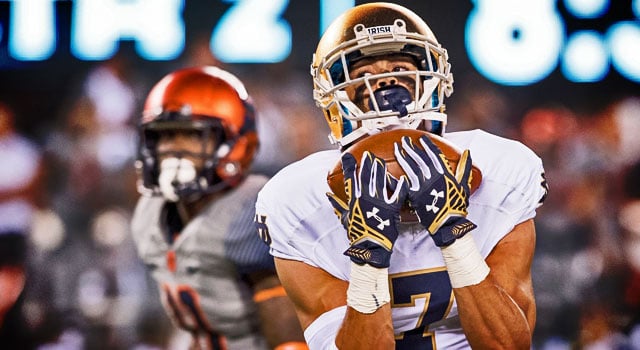

In the first four years of the Kelly hegemony, the Fighting Irish offense averaged 27.1 points per game. The Irish averaged 161 yards rushing and 246 yards per game passing for a total offense of 407 yards per game.
In 2014, Kelly installed Mike Denbrock as de jure Offensive Coordinator, but made himself the play caller. Points per game , through the 11th game of the regular season (USC had little predictive value) was 34.8 ppg, up by a touchdown or 25%, rushing yards per game down a smidgen to 154 yards per game and passing yards up 10% to 269 yards per game, with a total offense of 423 yards per game, a 4% increase.
Nine of the eleven full time starters (all but Koyack and Lombard) return.
The elephant in the room is that the Kelly regime, which had prided itself on controlling and limiting turnovers, fell apart in that area, with 13 interceptions and 11 LOST fumbles.
The big question going into 2015 is whether or not the Fighting Irish offense can slash turnovers in half and thus regain a positive turnover margin in 2015. Simply, we will not know until the end of September.
Position Unit Review
WIDE RECEIVERS
“The stone that the builder rejected has become the cornerstone”
Entering 2014, the two top receivers of 2013, T.J. Jones and Davaris Daniels, were unavailable. The third leading receiver, TE Troy Niklas, had left for the NFL. The top returning receivers were Chris Brown with 15 and Ben Koyack with 10. But this is a new era at Notre Dame. The depth chart is solid in nearly all areas, and player development is not a “project” but the way the program breathes. Seven 2014 receivers had double digit catches with 6 garnering 300 or more yards (Folston had 190). Only our old friend Koyack departs.
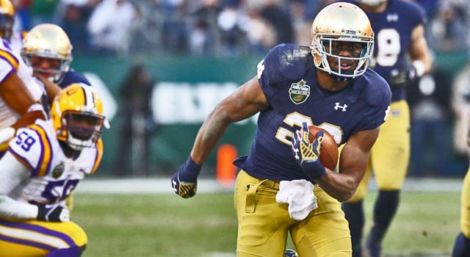
In 2014 Notre Dame had 30 wide receiving touchdowns. Players who accounted for 28 of those receptions return. Amir Carlisle is a fifth year player, Chris Brown and C.J. Prosise will be in their fourth year, with Corey Robinson, Will Fuller, Tarean Folston and Torii Hunter Jr in their third year on campus (Hunter of course had the injury redshirt). Suddenly this group is credentialed, deep and mature, and working with the same coach, Mike Denbrock, who recruited them.
Will Fuller emerged as the star, with 15 touchdowns, and diversified his portfolio beyond being a one trick (fly or post) pony. Chris Brown progressed, but did not explode. He may be able to elevate a level in 2015. Corey Robinson showed maturity, sharp running skills after the catch but was bothered all year by his broken thumb. His glue hands were mortal, even in the Music City bowl. C.J. Prosise averaged 17.8 yards per catch on his 29 receptions, and if you doubt his abililty to run the fly sweep, visit Baton Rouge and talk to Les Miles. Hunter showed glimpses, but frankly, and shockingly for Notre Dame fans, got caught in a talent glut at wide receiver! Carlisle was serviceable, not more, in the slot.
Now Justin “the Lothario” Brent has a full year under his belt. Corey Holmes, thought to be a “clone” (a misleading, deceptive and heartbreaking term) of T.J. Jones doffs his redshirt. C.J.Sanders may be an explosive kick returner and force his way onto the field. But it would appear that the four man class of Equanimeous Tristan Imhotep St. Brown, Miles Boykin, Jalen Guyton and Sanders could redshirt. All four of the frosh played receiver in high school, so there will not be the retooling from another position.
While, for now, only Fuller causes nightmares for defensive coordinators, this group made its bones in 2014 and should be ready for more porductivity in 2015. The single biggest noticeable improvement was the ability of the receivers to generate Yards after Catch (YACS) and this area may improve even more in 2015, Look for Robinson to shake off the thumb injury and become the elite receiver he previewed against Florida State. Hunter is now healthy and he is highly explosive. Robinson and Hunter are our two best current guesses to improve the most in 2015.
The receiving corps also went through a rite of passage in 2014 in Nashville. In the Sugar Bowl after the 2006 season, the Irish receivers could not get separation against the LSU defensive backs. It’s different now. They were able to get separation against the LSU defensive backfield in the Music City Bowl. This is not an insignificant development.
There is also a lot of speed. If Denbrock calls for his four fastest receivers to sprint against each other, Brown, Fuller, Prosise and Sanders will line up. Amir Carlise will not be in that top four. Don’t take the speed of this group for granted. It took a long time to get to this level.
There are great receiving corps at USC, Texas A&M, Ohio State and other places, so this bunch would probably rate a top ten ranking, but in the bottom half. Nevertheless it looks promising for 2015 and for years to come.
OFFENSIVE LINE.
HIESTAND HAS COMPLETED BUILDING HIS TRENCH
Spring 2014 was a challenging time, and Hiestand and Kelly may not have handled it correctly. Zack Martin and Watt had departed, while Hegarty, Martin and Lombard were struggling with a variety of health issues. They were not full go in the spring and available development time went unused. McGlinchey had the pole positon at RT, but could not secure the job, or, was not allowed to by Hiestand and Kelly.
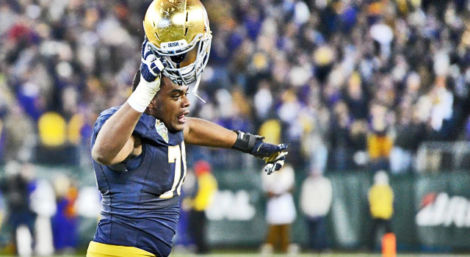
In pre-Fall the experiment with Elmer as a tackle and the inability of Martin to function at center and Hegarty to provide power at guard were puzzling. It might have been a case of excessive deference to the upperclassmen, and the coaches assuming (a deadly word) that they could come back at full strength from their respective medical hardships.
So the initial starting lineup of Stanley LT, Hegarty LG, Martin C, Lombard RG and Elmer RT was completely reshuffled. In October it became Stanley LT, Martin LG, Hegarty C, Elmer RG and Lombard RT. While this was the right change, the staff ought have been anticipating the weakness through Spring and pre-Fall. Then for USC, McGlinchey was given the starting job.
The October revised line had some moments. Notre Dame outrushed physical Stanford 129 to 47. Notre Dame outrushed quick Florida State 157 to 50. And Notre Dame, spotting LSU a Leonard Fournette, amassed 263 rushing yards the hard way.
The inside sharps say that Nelson has the pole position for left guard based on his performance in practice. He could follow Stanley and Elmer to start as a redshirt frosh. If Martin’s hand is healed and he moves back to Center, then the most probable offensive line is Stanley LT, Nelson LG, Martin C, Elmer RG and McGlinchey RT. There are some very aggressive, rough players on this line. McGlinchey was no wallflower against LSU and his mouth was as imposing as his frame. That is an asset, not a liability.
What’s astounding is comparing this 2015 PROJECTED OL to the 2012 OL that took the Irish to the championship game.
That 2012 OL averaged 6’3.6” 303 lbs. The 2015 line averages 6’5.5” 313 pounds. That’s two inches taller (or longer if you like) and ten pounds heavier. Elmer and McGlinchey are not fat and look as if they can add more weight. Given last season’s switches you have to ask if the staff will establish a first string OL early in Spring and stick to it. That will be vital for a fast start against a challenging early season schedule. Note that three of these guys, Nelson, McGlinchey and Elmer are handpicked recruits of Hiestand.
This line has depth. Hegarty, if he returns, has lots of playing-and starting experience. Harrell has played some. Collin McGovern, Hunter Bivin and John Montelus will be juniors in the Fall. Alex Bars, shockingly, received fulsome praise from Kelly who said he’s the best prospect he’s seen in 25 years of coaching. Sam Mustipher got some mention for his work learning the center position. Jimmy Byrne, a tough kid from Cleveland, will be a redshirt frosh, and Tristen Hoge is already on campus. Plus, for practice purposes, there are several preferred walk-ons.
This line has come some distance since 2012. These are two very athletic tackles, two bruising, bulky guys at guard, and a fifth year player and captain in Martin.
The dark side of the moon was the dreadful performance against Arizona State when the OL allowed 10 tackles for loss and seven sacks. That is horrific. Hopefully it was a one time occurrence, is out of the system, and the performance against LSU is indicative of things to come.
It would appear that Notre Dame, by the END of 2015, will have one of the top ten offensive lines in America. It could be near the top of that list. With Tommy Kraemer already committed for 2016, it appears that a “pipeline,” reminiscent of the great Milt Tenopir’s OL pipeline at Nebraska, is in place.
Ronnie Stanley stayed for his fourth year. This time next year, he will be on his way to evaluation at the combine as a probable first round draft choice. In years past such a loss would have been devastating to the Notre Dame offense. But in 2016, 6’6” 305 lbs (he’ll be bigger by then) wunderkind Alex Bars will slide in at left tackle. Nick Martin will be gone, but in Spring 2016 Mark Harrell (if he is deigned worthy of fifth year) Sam Mustipher, and the eager Tristen Hoge will be battling for the center job. It is obvious that Hoge will be motivated to be the best Irish player from the land of “Famous Potatoes” since Ernie Hughes, last seen shattering an Outland Trophy myth named Brad Shearer.
RUNNING BACKS.
There is good news and bad news….
The good news is the return of Tarean Folston and Greg Bryant. Tarean Folston finally took hold of the role of lead back and finished with a tidy 911 yards rushing. Folston has good vision, is patient reading his blocks and is shifty in space. His longest run was 26 yards so he is not a breakaway threat. He improved his blocking as the year went on, coming to grips with his inadequacies as exposed in Tempe.
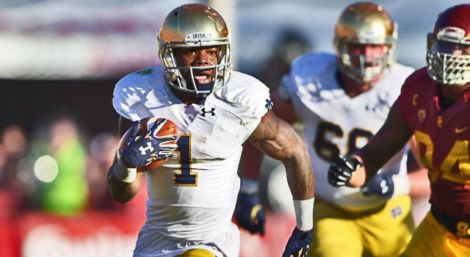
Greg Bryant began to emerge a bit with 300 yards rushing, and a 5.4 yard per carry average compared to Tarean Folston’s 5.1. Bryant is still working on patience and in following his blocks, but he has burst and it is probably that he will have a few more long runs than Folston will garner.
With two years of eligibility left for Folston and three for Bryant, the depth chart is solid at the top.
One of the pleasant, albeit underdiscussed developments of 2014 was the emergence of the passing game to the running backs. In 2013 the running backs caught 18 passes for 120 yards, a low number for a college team. In 2014 the running backs caught 32 passes for 316 yards, moving from 6 yards per catch to 9.4 yards per catch. This will be expected to progress again in 2015.
The bad news is that there are, for the Spring, no scholarship players behind Folston and Bryant. Running back is an area more susceptible to injury than most. Georgia last fall lost Todd Gurley, Keith Marshall and Sony Michel for some periods of time. So this is risky business.
Josh Adams and the more highly rated Dexter Williams will arrive in June. Most expect that Williams would be more ready to contribute than Adams, but in 2013 most expected that Bryant would make a greater contribution than Folston.
In any event this is a solid top twosome, albeit not spectacular. It is not a top ten unit by any stretch. It is expected that running back recruiting will be a continued point of emphasis for the 2016 recruiting class.
TIGHT ENDS
NOTRE DAME’S NEW PARADIGM
The 2015 Notre Dame offense is unusual in that only Ben Koyack departs as the entrenched full time starter (McGlinchey was passing Lombard late in the season.) It is unlikely that the Irish will be losing only one starter on a unit in any foreseeable year.
But this is a different Notre Dame program, with depth at most positions, and a rational, well-spaced balance to bringing players in.
Notre Dame will have four on-campus candidates for tight end playing time when Spring Practice begins. Durham Smythe will be in his third year on campus in 2015, as will the oft-injured Mike Heuerman. Tyler Luatua will be a sophomore and pass catching whiz Nic Weishar a redshirt frosh. Alize Jones will arrive in June. Every player on the depth chart has at LEAST three years of eligibility remaining.
So far, Kelly and his staff have replaced, effectively, Kyle Rudolph, Tyler Eifert and Troy Niklas. While there are no assurances, it is probable that they can replace, effectively, Ben Koyack. This is the new Notre Dame paradigm. A NFL caliber player departs and there are a handful of players available, some with at least two years of lifting and player development.
This area in terms of unproven achievement, resembles the wider receiver corps as 2014 began. Smythe was regarded as a downfield threat when he was recruited. Kelly complimented his work to bulk up, toughen up and Kelly pronounced him, over the Summer, competent to function as an in-line blocking tight end.
The burly Luatua often functioned as a sixth lineman in short yardage and goal line situations. Heuerman has been injury plagued, but Weishar was as celebrated a pass catcher as Smythe was as a high school player.
It is not inconceivable that the following two seemingly paradoxical statements will be accurate regarding Notre Dame’s tight ends:
- Notre Dame does not have a tight end returning who is on the list of the top 100 most accomplished, credentialed, proven and experienced tight ends in America.
- Notre Dame’s 2015 roster will contain three Tight Ends who will earn regular paychecks in the NFL
The battle will rage in the Spring. It will escalate when Alize arrives from Las Vegas in June. But one wonders: If Tight End, as one would think, is our “weak spot” than just how good can this 2015 offense be?
QUARTERBACK
Rites of Spring in South Bend (past and present)
- An Tostal
- Bookstore Basketball
- Michigan Dunes
- Quarterback controversy
And we are right on schedule.
Much will be said speculated, projected, “guaranteed,” conjectured, shouted, whispered and hotly debated about Notre Dame’s starting quarterback. The “more heat than light” syndrome will be evocative of The Comet Kohoutek, Y2K, Avian Flu, The Mayan Calendar foretelling doom and the Ebola non-crisis.
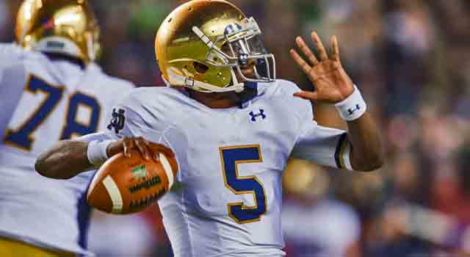
But first, for something completely different, let’s try “perspective.” When Kelly and his droogs arrived, their first quarterback meeting had to be ADA compliant as Dayne Crist hobbled in on crutches. But when the Spring semester began, Crist was joined by that wunderkind, the heir to the hype of Hornung, Koegel, Mirer and Powlus: Tommy Rees.
It’s different this time. Everett Golson will be entering his fifth collegiate year (somewhere). Malik Zaire, with one wonderful purple and gold notch on his belt from the LSU win, will be entering his third year. Rangy Deshone Kizer, he of the bazooka arm, will be a redshirt frosh, and chomping at the bit, and prep phenom Brandon Wimbush will arrive in June.
This is not 2010’s qb depth chart.
Dr. Jekyll Golson.
Golson had been the designated starting quarterback for Notre Dame teams with an 18-1 record, with the sole loss to Alabama. It was October 18th in Leon County, Florida, and with 17 seconds left in the game, Golson completed a pass to Corey Robinson in the end zone of the defending national champion Florida State Seminoles, putatively bringing Dr. Jekyll Golson to 19-1. But a Zebra, of a most vile and odious stripe, intervened.
Mr. Hyde Golson.
November was the cruelest month, breeding turnovers and defeat out of the cold, wet ground. Mr. Hyde Golson was only 1-4 in November, threw 8 interceptions during the month, and before halftime of the USC game, was a shattered shell of the Dr. Jekyll Golson.
It is one of the more unusual implosions of a football player, in recent Notre Dame history. Golson was, however, highly effective against LSU.
No one, not Kelly, not Golson, not Denbrock, not LaFleur knows beyond a shadow of a reasonable doubt how Golson will respond during the Spring and the Fall. We must wait, and then, later, much later, we will see.
Zaire was passable against USC, solid as a rock against LSU. It is worth noting that against LSU Zaire was the best passer in the starting lineup for either team. In 2015, that will not always, or perhaps often, in key games, be the case. And there is the rub.
Kizer will be no shrinking violet. It should be an entertaining Spring, and the battle may rage through June and well into Pre-Fall.
Kelly is the head coach at Notre Dame for a reason. If he can restore the confidence of Golson he will give Golson the chance to demonstrate that he is worthy of the starting role. Stopping the turnovers will be key. Notre Dame plays Texas on September 5th in Notre Dame Stadium. We’ll know the starting quarterback that afternoon. And that is the only certainty.
This offense was vastly improved in 2014, in spite of the turnover epidemic and the issues with Golson.
If tight end is the weak spot, then this is a very strong offensive roster. It is highly experienced. We now have studs along the offensive line and playmakers at wide receiver and running back. Resolving the quarterback issue is clearly the fulcrum. But stick around, it just may be interesting in the Fall. You never know, it might be fun.
Go Irish!!
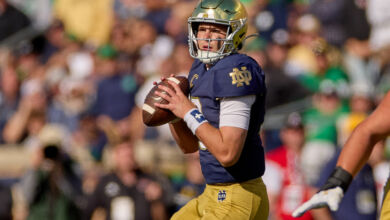
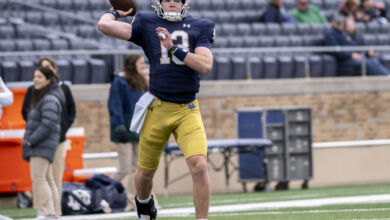
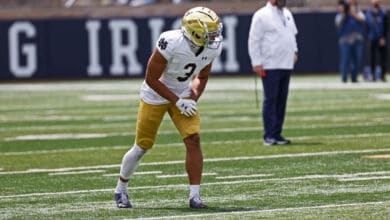
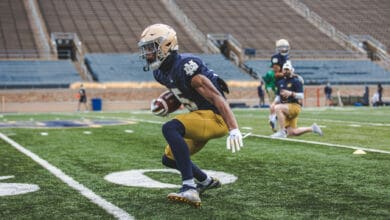

I agree. Run the damned ball, including the read option by whichever QB is in there. Zaire may be a better runner than Golson, but Golson is supposed to be a great athlete and basketball player. On one of the few plays this year when Golson kept the ball he ran for a 61 yard TD against Northwestern. The threat of a QB run can’t help but to loosen up the defense for the running backs.
Shaz, Elijah Hood was committed, albeit briefly. And they went after Bo Scarborough vigorously. They went after Sotonye Jamobo vigorously.
A compounding problem is that a young kid of that size is better off, if considering a pro payday, to move to linebacker. Shaq Thompson, who will be a first rounder at linebacker, took one for the team at Washington this year, but still was the Huskies’ best rb when he played there this year.
But there’s another factor, was FSU better this year when Karlos Williams was in the game or when Dalvin Cook was in the game? Was the Ohio State running attack more dangerous with Carlos Hyde or with Zeke Elliott?
Further, riddle me this, why did Lou, in ’89 and ’90 often sit his bigger backs in the fourth quarter and run Ismail from tailback as a piece de resistance?
Which is the propf and reason for the trend… In the zone scheme, size is much less important than an ability to read and react quickly and decisively. This tends to be the foray of smaller RBs, but when big guys have quick reaction time and good footwork, it looks like marshawn lynch.
Big-D,
I see an area of imbalance in this Irish offense which could be addressed with a pure power back who can run between the tackles.
While a big, intimidating bruiser would be ideal, for the current ND offense, all ND really needs is someone who’s good for 7 or 8 tough, positive, inside carries a game.
Someone who can bull his way for a yard on 3rd and 1, 4th and 1, or from the 1 yard line in the red zone.
Someone with enough size, power, and ability, to be a legitimate inside running threat and therefore command the attention and respect of the opposing defense.
To put it in context, think of the last time (as painful as it is) that ND lost to Navy(2010, Kelly’s first year as ND head coach)
The Navy option always starts with the fullback(dive).
That day the Navy fullback was a guy by the name of Alexander Teich.
He carried the ball 26 times for 210 yards.(career highs) against ND.
ND was “forced” to deal with him, first and foremost, in the Navy offense.
What followed was Navy QB Ricky Dobbs scoring 3 TD’s on just 20 carries.
(Dobbs was also 2 for 2 passing for 71 yards and a TD.)
Doesn’t matter what kind of offense your running.
If the defense must commit(Hopefully a majority of its players) to stopping the inside run game, or even the threat of it, it opens up the edge, enhances play action, and provides many more options in short yardage.
Too many times have I seen ND throw the ball at the goal line in the Red Zone.
Why? Because they had no other viable option? They had no confidence in the backs they had?
To me, that sends an unfortunate message.
To your own team, as well as your opponent.
I believe this is a part of the game you need have if you aspire to be a champion.
bettis was the absolute beast
why cant we find that guy again?
peace
and larry conjar
https://www.youtube.com/watch?v=a7q3AVkcDY0
That was well before my time pops, and probably before the invention of the Television, and certainly well before today’s version of college football.
I do know Conjar played at 215 lbs.
Hardly in the same class as Brooks and Bettis.
But I’m sure he sounded bigger on the radio.
Bettis just inducted into the pro hall of fame and Brooks, Tony’s little brother who became a great ND RB. Ah! The memories. Remember the run versus Michigan, thru Corwin Brown, knocked unconscious yet still scoring a TD?
bj- this clip’s for you.
https://www.youtube.com/watch?v=X6j_GnIb2pY
I like the running backs ND currently has and have signed.
But when I look down the roster I feel like there still a piece or two missing, and I think one of those is not having a big bruising running back.
It’s something I haven’t seen here in a while.
I harken back to my memories of running backs like Jerome Bettis, Reggie Brooks, Rodney Culver, Marc Edwards, & Ray Zellers.
Big, powerful, athletic running backs who gave their Irish teams’ an air of intimidation, brute strength, and overwhelming confidence, and
opposing defenses a sick sinking feeling of impending doom.
Hell, I’d wager they had a third of their games already won by the time the opposing defense finished their film study for that
Week’s game!
It appeared Brian Kelly was too invested in Everett Golson last season. But how do you bench a quarterback that was 6-0 and one questionable play call and penalty from being 7-0. I can help but think what may have happened had Zaire been given an opportunity to play before USC. I’m thinking wins against Northwestern and Louisville would have been a lock. Running the football is the key. And now that everyone can see how Malik is a better runner than Everett it should help the running game explode. I think a two quarterback system is a stretch in most cases but not ours. If these guys can keep their egos in check our opponents are going to be kept on their heels all season long. I hope BK doesn’t overthink it. Go Irish!
Great article Duranko. Finally Nic Weishar gets some props. Saw him play for Marist high school(FAR southside in Chicago)and he reminded me of Jeff Samardzija or Tyler Eifert. ND sure could use TE weapon more often this season to get back to TE-University. Maybe Weishar or Jones are the weapons ?
Now we need a defensive line coach!
Great read!
Kelly is still the coach, so empirical evidence suggests that ND will stumble and bumble its way through another lackluster year squandering talent that would start for any other school in America.
One of the journalists on this site should publish a description of the offense that Kelly runs…or tries to run, when his QB can make the right decisions. I’d bet the vast majority don’t really understand what they’re seeing, and are viewing the game in the context of 80’s pro formation football. My guess is it’s especially confusing when Zaire is the first QB in Kelly’s time to be capable, though it’s been tried to death with Golson.
Zaire will run the ball, just like he did against LSU…because that’s the point of the read option, and also why he looks more like a running back than a classic QB.
The line is less to blame than so many observers think. They aren’t clearing a hole that the RB is supposed to hit. Their 1st level blocking assignments are generally set at snap, but the 2nd level (LB’s) assignments are totally contingent upon their movement and the QB’s ability to make his option read. If he messes up, a LB/DL go free. It makes the line look awful to the casual observer, but the fault is most often not their own. This is only compounded by a QB that flushes the pocket consistently and unnecessarily. Whether it leads to an occasional broken scramble, or playground pass; it’s only time before DC’s see panic or confusion, and bring the pressure. As the pressure increases, so go the mistakes.
No more gold on .Zaire is a far better athlete . Come on coach we have seen enough of gold on give Zaire a chance.
Some might say it is not a matter of confidence with Golson. Defenses caught up with him. Early on, he did well when plays broke down. He is good at schoolyard ball. But part of the reason plays broke down was that Golson has trouble reading defenses, does not anticipate blitzes well, is not a good decision-maker and does not have a good football IQ. When teams learned to disguise their defenses better and blitzed more effectively, Golson’s game deteriorated.
In his fifth year, Golson is likely to be the starter once again. He is, after all, Kelly’s protege. He is also likely to be the same Golson we have seen up till now, both good and bad.
Great work, once again.
Keep it up, Duranko!
I recommend speaking to the players themselves to see who the fastest players are and which ones are the best athletes on the team. They know the TRUTH!!!
Injuries can be devastating to any team, not just Notre Dame. As proven by teams like Ohio State, they emerge and find a way. ND will have injuries in 2015 – that is guaranteed. Quality depth is what negates the injuries inherent to football.
I also don’t see the LSU game as something that allows the 2015 opponents to “shut ND down.” A novice can watch a game, see what a team does and come up with ways to stop. What prevents that is talent, technique, heart, scheme and adjustments.
Every team in the nation has a scouting/tendency report. It doesn’t mean Ohio State will go 3-9 next year. Or Alabama will fail to break .500. Or FSU will go winless. The great teams do what they do best (even when everyone in the world knows what they’re going to do) and it still can’t be stopped.
If teams did 180 degree philosophical turns based on film footage their opponents see, well . . . that’s how loss of identity and losing records are born.
Right on Knute … If and when that msg gets across to Kelly will be when (and only when) we start to win championships again.
http://bleacherreport.com/tb/dfZQl?utm_source=newsletter&utm_medium=newsletter&utm_campaign=notre-dame-football
On a side but related note, welcome Mike Sanford, Boise State OC to ND. Good hire.
RTDB. Run the damn ball. You have the horses up front. Run the ball. This not only allows for ball control, time of possession leads, wearing out opposing defenses, keeping your defense fresh, but most importantly limits mistakes Golson, or whomever the QB is by not letting them wing it all over like its grade school recess…..
I’m not a diehard advocate of RTDB. Zaire had a lot of those running yards against LSU, and you really can’t have him running that much if you want to preserve him. Also, everybody saw what he did and defenses will be more ready for him come September. We also have depth problems at running back and a couple injuries could be devastating (although Carlisle and Prosise could be inserted at running back). Even so, the LSU game was really fun to watch as our line dominated an opponent! I hope we can maintain balance and control, and then pound teams into oblivion in the fourth quarter.